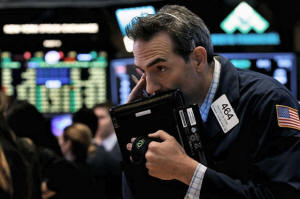|
Regional banks may keep
lagging without Washington lift
 Send a link to a friend
Send a link to a friend
 [June 10, 2017]
By Sinead Carew and Megan Davies [June 10, 2017]
By Sinead Carew and Megan Davies
NEW YORK (Reuters) - A rough few months for
most U.S. bank stocks has been particularly unkind to regional banks,
and thatís not likely to change soon as hopes dim for higher long-term
interest rates and timely policy relief from Washington.
While some investors see bargains in lower valuations of regional banks'
shares, few can point with any confidence to near-term catalysts for a
turnaround in their fortunes.
After outperforming larger banks in the wake of the Nov. 8 U.S.
Presidential election, the S&P 600 index <.SPSMCBKS> of small cap banks
are down 8.1 percent so far this year, data through Thursday showed,
while the S&P 500 index of the biggest U.S. banks <.SPXBK> is unchanged.
The full S&P 500 <.SPX>, meanwhile, is up 8.7 percent.
Last year, investors bet heavily that smaller, entirely U.S.-focused
banks would benefit most from Donald Trump's promises of tax cuts,
deregulation and economic stimulus.
But those hopes dwindled dramatically as it became clear that President
Trump would have difficulty gaining enough support to deliver on any of
his pro-growth proposals.
"I would expect (smaller banks) to continue to underperform as long as
we don't get some of these policy decisions to move through," said
Stephen Scouten, banking analyst for Sandler OíNeill in Atlanta.

Fading hopes for an economic boost from Trump's agenda has compressed
the gap between short- and long-term interest rates, putting pressure on
bank loan profit margins. This is a bigger issue for regionals which
have a greater dependence on lending for their profits than bigger, more
diversified banks.
Also, commercial and industrial loan growth has slowed this year after
climbing steadily since late 2010. The Federal Reserve's latest Senior
Loan Officer Opinion Survey, released May 8, showed domestic banks
reporting weaker commercial and industrial loan demand from firms of all
sizes in the first quarter.
WAITING FOR CLARITY
Part of the problem is that companies are waiting for clarity on
economic growth prospects and tax rates before making borrowing
decisions, according to investors and analysts.
"Eventually, for the smaller banks to outperform, concerns about the
overall economy need to dissipate. Better economic growth usually leads
to better lending growth and in that environment the yield curve
steepens as well," said Brian Kleinhanzl, analyst at Keefe, Bruyette &
Woods in New York.
Short selling has decreased in most regional and diversified banking
sectors so far this year. But short interest in both the SPDR S&P Bank
Exchange Traded Fund <KBE.P> and SPDR S&P Regional Banking ETF <KRE.P>
increased as short sellers may be replacing exposure to individual banks
with short bets on the sector.
[to top of second column] |

Traders work on the floor of the New York Stock Exchange (NYSE) in
New York, U.S., May 22, 2017. REUTERS/Brendan McDermid

Short interest in the S&P bank ETF is up 36 percent for the year while it is up
23 percent in the regional banking ETF.
While tax cuts are viewed as one of the biggest boosts for regional banks of all
Trump's policy proposals, investors are skeptical it will come any time soon.
JPMorgan analysts on Thursday scaled back their forecast on the size of possible
U.S. tax cuts and pushed out the timing to the second quarter of 2018 from the
third quarter of 2017.
White House economic adviser Gary Cohn has said he expects U.S. Congress to get
tax reform done this year. But investors say 2018 would likely be the earliest
this could happen.
Treasury Secretary Steven Mnuchin is expected this month to unveil plans for
regulating the U.S. banking sector including a relaxation of regulations for
community banks, which have struggled with rules imposed after the 2007 to 2009
financial crisis.
While investors expect the administration to have trouble winning congressional
support for legislative changes to regulations such as Dodd-Frank, some are
hoping Trump will be able to appoint people to key regulatory positions.
If Trump can replace the Federal Reserve's head of banking supervision, this
might at least help slow the pace of regulation, said investment managers.
Trump is expected to nominate Carnegie Mellon University professor Marvin
Goodfriend and former Treasury Department staffer Randal Quarles to fill two of
three open seats at the Fed, according to a New York Times report.
"If they do get traction and get some of these (policy changes) done, even if
they're more watered-down versions of what they had proposed, that's probably
very good for sentiment and good for the fundamentals," said Miles Lewis,
portfolio manager for American Century Investments' Small Cap Value fund.
For a graphic on regional banks running out of steam, click
http://reut.rs/2s8NYep
(Reporting by Sinead Carew and Megan Davies; Editing by Bill Rigby)
[© 2017 Thomson Reuters. All rights
reserved.] Copyright 2017 Reuters. All rights reserved. This material may not be published,
broadcast, rewritten or redistributed.
 |